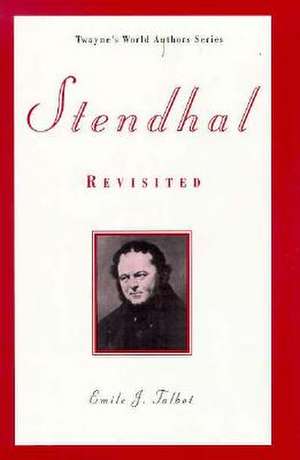World Authors Series: Stendhal Revisited: Twayne's World Authors, cartea 839
Autor Emile Talboten Limba Engleză Hardback – 31 aug 1993
Devoted to critical interpretation and discussion of an author's work, each study takes account of major literary trends and important scholarly contributions and provides new critical insights with an original point of view. An Authors Series volume addresses readers ranging from advanced high school students to university professors. The book suggests to the informed reader new ways of considering a writer's work.
Each volume features:
-- A critical, interpretive study and explication of the author's works
-- A brief biography of the author
-- An accessible chronology outlining the life, the work, and relevant historical context
-- Aids for further study: complete notes and references, a selected annotated bibliography and an index
-- A readable style presented in a manageable length
Din seria Twayne's World Authors
-
 Preț: 486.49 lei
Preț: 486.49 lei -
 Preț: 489.92 lei
Preț: 489.92 lei -
 Preț: 375.22 lei
Preț: 375.22 lei -
 Preț: 464.92 lei
Preț: 464.92 lei -
 Preț: 464.54 lei
Preț: 464.54 lei -
 Preț: 465.13 lei
Preț: 465.13 lei -
 Preț: 376.75 lei
Preț: 376.75 lei -
 Preț: 377.52 lei
Preț: 377.52 lei - 23%
 Preț: 427.79 lei
Preț: 427.79 lei -
 Preț: 462.41 lei
Preț: 462.41 lei -
 Preț: 374.23 lei
Preț: 374.23 lei -
 Preț: 375.22 lei
Preț: 375.22 lei -
 Preț: 375.98 lei
Preț: 375.98 lei -
 Preț: 373.09 lei
Preț: 373.09 lei -
 Preț: 377.72 lei
Preț: 377.72 lei -
 Preț: 378.48 lei
Preț: 378.48 lei -
 Preț: 375.39 lei
Preț: 375.39 lei -
 Preț: 373.47 lei
Preț: 373.47 lei -
 Preț: 375.39 lei
Preț: 375.39 lei -
 Preț: 375.22 lei
Preț: 375.22 lei -
 Preț: 483.60 lei
Preț: 483.60 lei -
 Preț: 485.29 lei
Preț: 485.29 lei -
 Preț: 487.42 lei
Preț: 487.42 lei -
 Preț: 484.53 lei
Preț: 484.53 lei -
 Preț: 485.90 lei
Preț: 485.90 lei -
 Preț: 485.51 lei
Preț: 485.51 lei -
 Preț: 488.40 lei
Preț: 488.40 lei -
 Preț: 484.53 lei
Preț: 484.53 lei -
 Preț: 487.81 lei
Preț: 487.81 lei -
 Preț: 487.25 lei
Preț: 487.25 lei -
 Preț: 486.28 lei
Preț: 486.28 lei -
 Preț: 483.60 lei
Preț: 483.60 lei -
 Preț: 482.23 lei
Preț: 482.23 lei -
 Preț: 486.28 lei
Preț: 486.28 lei -
 Preț: 482.23 lei
Preț: 482.23 lei -
 Preț: 513.42 lei
Preț: 513.42 lei -
 Preț: 484.37 lei
Preț: 484.37 lei -
 Preț: 487.25 lei
Preț: 487.25 lei
Preț: 375.39 lei
Nou
71.84€ • 74.58$ • 59.90£
Carte indisponibilă temporar
Specificații
ISBN-10: 0805782885
Pagini: 171
Dimensiuni: 148 x 226 x 20 mm
Greutate: 0.38 kg
Ediția:New.
Editura: Twayne Publishers
Seria Twayne's World Authors
